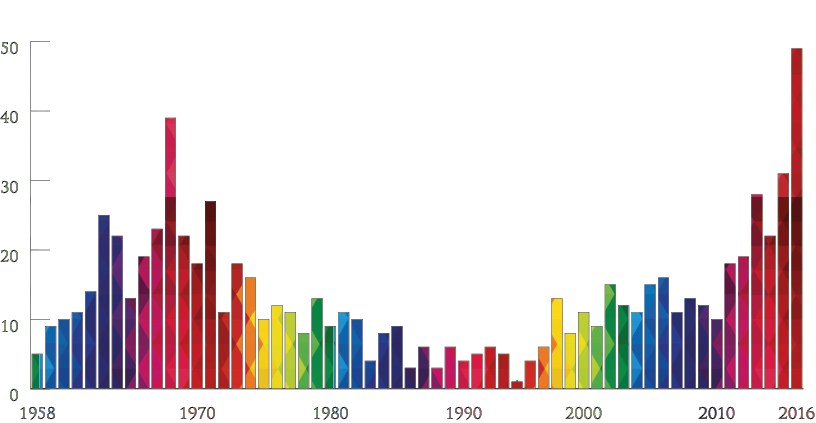Psychedelics have fascinated humans for centuries and have a long history in ancient cultures. From shamanic rituals in the Amazon to sacred mushroom use in Mesoamerica, these substances have long been used as tools for healing, creativity, and spiritual insight. However, the Western world only began to rediscover their power within the last century. Psychedelics’ richer history in the west has come within the last 100 years. From first rediscoveries, revolutions, and prohibition–psychedelics have always held some level of interest. Today psychedelics have had a huge resurgence and renaissance since the 2000s. New research and discoveries have pioneered this new field of study as we are now starting to know more about psychedelics than ever before. Let’s take a look in today’s blog for a simple summary of psychedelic history in the modern western world.
Early Western Encounters (1940s–1950s)
The discovery of these compounds started coming to light in the late 30s, early 40s. Albert Hofmann was the first to discover and synthesize LSD in 1938 and discovered its effects in 1943 (the infamous bicycle day). Early studies of psilocybin by R. Gordon Wasson and Timothy Leary at Harvard. During these new discoveries, psychedelics were starting to be seen as potential tools in psychiatric medicine. Researchers began exploring their use for treating depression, alcoholism, and trauma, reporting breakthroughs that challenged conventional psychology. Psychedelics were viewed not just as drugs but as gateways to understanding the human mind. This was a period of time where psychedelics were viewed with optimism and curiosity. Dozens of academic papers were published worldwide, laying the groundwork for what many now call the first psychedelic revolution. Research started to boom and these compounds were looked at with fascination and mystery.
The Counterculture Revolution (1960s)
As the 60s came around, psychedelics started making its way out of just labs and research and made its way into mainstream culture. Psychedelics crept into art, music, and spiritual exploration. Counterculture and hippie movements started rising in popularity. Artists like The Beatles, Pink Floyd, or Jimi Hendrix among many others, started experimenting with psychedelics and incorporated it into their art. The idea of “turn on, tune in, drop out” coined by Timothy Leary and phrases started gaining traction as the movement slowly grew in popularity. Becoming a symbol of freedom and rebellion in the new movement. Many things came from the movement but when it came to the governments, they weren’t a fan. The government started pushing back against the counterculture movement as psychedelics started becoming a part of the anti-establishment movements.
The War on Drugs and Decline (1970s–1990s)
When the war on drugs was declared, psychedelics started getting banned worldwide. The research and funding for finding the potential therapeutic aspect of psychedelics were cut off. Heavy campaigns went forth, its goal to stigmatize and demonize psychedelics. Commercials and government ads went out demonizing these compounds. These bans led to what was essentially the “dark age” of psychedelic research. Public fear grew rapidly as misinformation spread, and those who advocated for psychedelics were often labeled as outcasts or criminals. Universities shut down studies, and decades of promising data were forgotten. Yet, curiosity never fully disappeared. During this time the flame was still kept alive by more underground communities and old indigenous traditions that kept psychedelics alive during this period. This period lasted all the way up until the 2000s but the stigma and misinformation around these compounds are still around today.
The Psychedelic Renaissance (2000s–Present)
The psychedelic renaissance. In the 2000s psychedelics made a resurgence. Curiosity about them started to peak and research on these compounds began to start again. Many people started to push for the therapeutic potential of these compounds to be better understood and implemented into the world of medicine. Institutes like John Hopkins and MAPS reopened clinical research of these substances. Many new emerging studies started to really cement progress in finding evidence of psychedelics’ beneficial effects. DMT, LSD, MDMA and many other substances became points of interest as we worked to find what was so unique and beneficial about each compound. This period also introduced new conversations around integration and how to bring insights from the psychedelic experience into daily life. Therapists and researchers began fusing ancient tradition with modern psychology, exploring how mindfulness, set, and setting influence the journey. The renaissance isn’t just scientific, it’s philosophical and cultural, reflecting a deeper desire for connection, empathy, and meaning in an increasingly disconnected world. Popular culture started picking it up again, with microdosing movements, music festivals and documentaries all trying to bring the psychedelic spark of the 60s back. Even legalization efforts started in parts of Canada and the USA. This new chapter is unfolding right in front of us and we have never been more excited at what’s to come. Hallucinogenics is proud to be a part of facilitating these powerful tools in this modern renaissance, providing safe and lab-tested products to help people embark on psychedelic exploration. You can learn more about us here.

Conclusion
The story of psychedelics has had some incredible ups and downs. Going from a new discovery, cultural icons, to forbidden and demonized, we now get to see the revival of these healing medicines unfold in front of us as the 2000s brought back light into this space. Even after decades of propagated fear and misunderstanding, we have come to reopen our search for truth and consciousness with these powerful compounds. As long as these compounds continue to be approached with safety and caution, there will be no limit to how beneficial these compounds can be. Psychedelics have helped a huge number of people and are only bound to help many more as research and legislation efforts continue. This modern renaissance is not only scientific but spiritual, reminding us of the deep human desire to explore the mind and expand awareness. As our understanding grows, psychedelics may once again become tools for connection, healing, and transformation. This story reminds us that despite the trials and tribulations it might take, truth finds its way to reveal itself.



